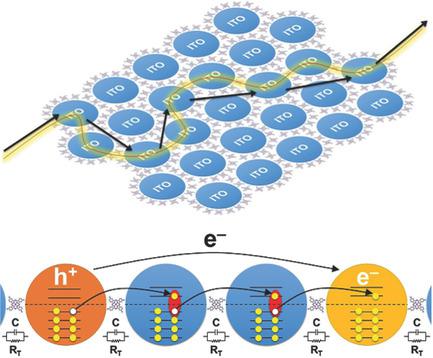当前位置:
X-MOL 学术
›
Adv. Mater. Interfaces
›
论文详情
Our official English website, www.x-mol.net, welcomes your feedback! (Note: you will need to create a separate account there.)
Tunable Charge Transport in Hybrid Superlattices of Indium Tin Oxide Nanocrystals and Metal Phthalocyanines—Toward Sensing Applications
Advanced Materials Interfaces ( IF 5.4 ) Pub Date : 2018-02-26 , DOI: 10.1002/admi.201701623 Mahdi Samadi Khoshkhoo 1 , Yvonne Joseph 2 , Santanu Maiti 3 , Frank Schreiber 3, 4 , Thomas Chassé 1, 4 , Marcus Scheele 1, 4
Advanced Materials Interfaces ( IF 5.4 ) Pub Date : 2018-02-26 , DOI: 10.1002/admi.201701623 Mahdi Samadi Khoshkhoo 1 , Yvonne Joseph 2 , Santanu Maiti 3 , Frank Schreiber 3, 4 , Thomas Chassé 1, 4 , Marcus Scheele 1, 4
Affiliation

|
Macroscopic superlattices of tin‐doped indium oxide (ITO) nanocrystals (NCs) are prepared by self‐assembly at the air/liquid interface followed by simultaneous ligand exchange with the organic semiconductors M‐4,4′,4″,4″′‐tetraaminophthalocyanine (M4APc, M = Cu, Co, Fe, Ni, Zn). Transport measurements, focusing on the effect of the metal center of the ligand, reveal a ligand‐dependent increase in electrical conductance by six to nine orders of magnitude, suggesting that M4APc provides efficient electronic coupling for neighboring ITO NCs. The resulting I–V characteristics as well as the temperature dependence (7–300 K) of the zero‐voltage conductance indicates that at low temperatures, transport across the arrays occurs via a sequence of inelastic cotunneling events, each involving ≈3 ITO NCs. At higher temperatures, a crossover to 3D Mott‐variable range hopping mechanism is observed. Finally, the vapor sensitivity of chemiresistors is investigated made from ITO NCs coupled via Cu‐ and Zn4APc by dosing the sensors with 4‐methyl‐2‐pentanone (4M2P), toluene, 1‐propanol, and water in the concentration range of 100–5000 ppm at 0% relative humidity. The nanocrystal superlattices respond with an increase in resistance to these analytes with the highest sensitivity to 4M2P.
中文翻译:

铟锡氧化物纳米晶和金属酞菁混合超晶格中的可调节电荷传输—面向传感应用
锡掺杂的氧化铟(ITO)纳米晶体(NC)的宏观超晶格是通过在空气/液体界面处自组装,然后与有机半导体M‐4,4′,4″,4″′‐同时进行配体交换而制备的四氨基酞菁(M4APc,M =铜,钴,铁,镍,锌)。传输测量着重于配体金属中心的作用,揭示了依赖于配体的电导增加了六到九个数量级,这表明M4APc为相邻的ITO NC提供了有效的电子耦合。结果IV零电压电导的特性和温度依赖性(7–300 K)表明,在低温下,通过一系列非弹性共隧穿事件发生了跨阵列的传输,每个事件涉及≈3个ITO NCs。在更高的温度下,观察到与3D Mott可变范围跳变机制的交叉。最后,通过向传感器中加入4-甲基-2-戊酮(4M2P),甲苯,1-丙醇和水的浓度范围为100-相对湿度为0%时为5000 ppm。纳米晶超晶格以对4M2P的最高灵敏度响应于这些分析物的抗性增加。
更新日期:2018-02-26
中文翻译:

铟锡氧化物纳米晶和金属酞菁混合超晶格中的可调节电荷传输—面向传感应用
锡掺杂的氧化铟(ITO)纳米晶体(NC)的宏观超晶格是通过在空气/液体界面处自组装,然后与有机半导体M‐4,4′,4″,4″′‐同时进行配体交换而制备的四氨基酞菁(M4APc,M =铜,钴,铁,镍,锌)。传输测量着重于配体金属中心的作用,揭示了依赖于配体的电导增加了六到九个数量级,这表明M4APc为相邻的ITO NC提供了有效的电子耦合。结果IV零电压电导的特性和温度依赖性(7–300 K)表明,在低温下,通过一系列非弹性共隧穿事件发生了跨阵列的传输,每个事件涉及≈3个ITO NCs。在更高的温度下,观察到与3D Mott可变范围跳变机制的交叉。最后,通过向传感器中加入4-甲基-2-戊酮(4M2P),甲苯,1-丙醇和水的浓度范围为100-相对湿度为0%时为5000 ppm。纳米晶超晶格以对4M2P的最高灵敏度响应于这些分析物的抗性增加。



























 京公网安备 11010802027423号
京公网安备 11010802027423号